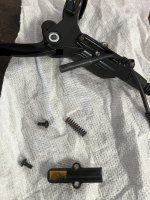To know what happened, we'd need to know the circumstances from when / before the failure started; you'd have to get taht ifno from the rider. Anything else we provide is a guess based on insufficient information.
----->My customers are not always truthful or accurate when reporting.
But...everybody always tells the complete truth about their problems and circumstances, never leaving anything out and never lying! :lol:

Yeah, I know...it's very common here for people asking for help to be that way, which doesn't help us help them; same thing back when I fixed computers for a living, etc. :/
Do the levers fully retract when let go? (manually moving them back to the stops doesn't change the output)
----->Yes, levers retract and no change to the output. These are simple 2-wire brakes.
If the switches themselves are stuck on, even when disconnected from the system, there could be a mechanical malfunction inside the switch, or too high a base pressure in the system keeping them triggered (since they're supposed to trigger with just barely enough lever usage to engage them but not the brakes themselves).
-----> I'm thinking high pressure might be the case because the brakes are very hard and the levers are fully retracted.
If they aren't stuck on when disconnected from the system, but the system still reads both of them engaged, there's a problem with the system-side connectors, wiring, or electronics.
-----> The levers are tested unplugged, and show a continuous short. Bike runs fine without brakes connected.
Some ebrake levers use simple mechanical switches that are either open or shorted, no power required to test / operate. These are easy to test with a multimeter.
-----> I'm thinking now that the magnet that actives the sensor never gets close enough.
Is it a magnet with reed switch, or a mechanical switch?
If it's a reed, sometimes these stick on, and occasionally, tapping the actual reed will unstick them...but more often they're just stuck and have to be replaced. I don't remember any I've seen stuck open.
Most reeds are made so they are open until the magnet is close enough, and close when it is within a certain distance. There *are* NC reeds as well, but they're less common.
Most of the mechanical switches used are NC, so as long as the button is held in by the lever being unpulled, the switch is open--when the lever is pulled far enough (not very far, a few mm at most) the switch button pops up and it closes. Their failure mode is usually stuck closed, depending on their actual internal mechanism, but certain types will stick open and fail to close.
If it's a pressure-activated switch, it is probably not a reed type, and the switch itself is probably not bad, but more likely there's just too much pressure in the system. Bleeding the brakes a teensy bit would probably fix that problem. It's not very likely that it's pressure-activated, simply because that's a more complicated and expensive type of switch, and because it does have the potential to do this.
There may be a removable cover over the switch area; some have this for servicing. If so, it may help you find out what switch is in there, if the manufacturer of the brake system doesn't specify on their pages or the service/user manual for the system.
A google for images of "Logan" brake levers finds some like this that appear to have such covers, but I don't know if they ae for the switch or the reservoir or if these are cable-type, since they just came from the google image search page directly.






